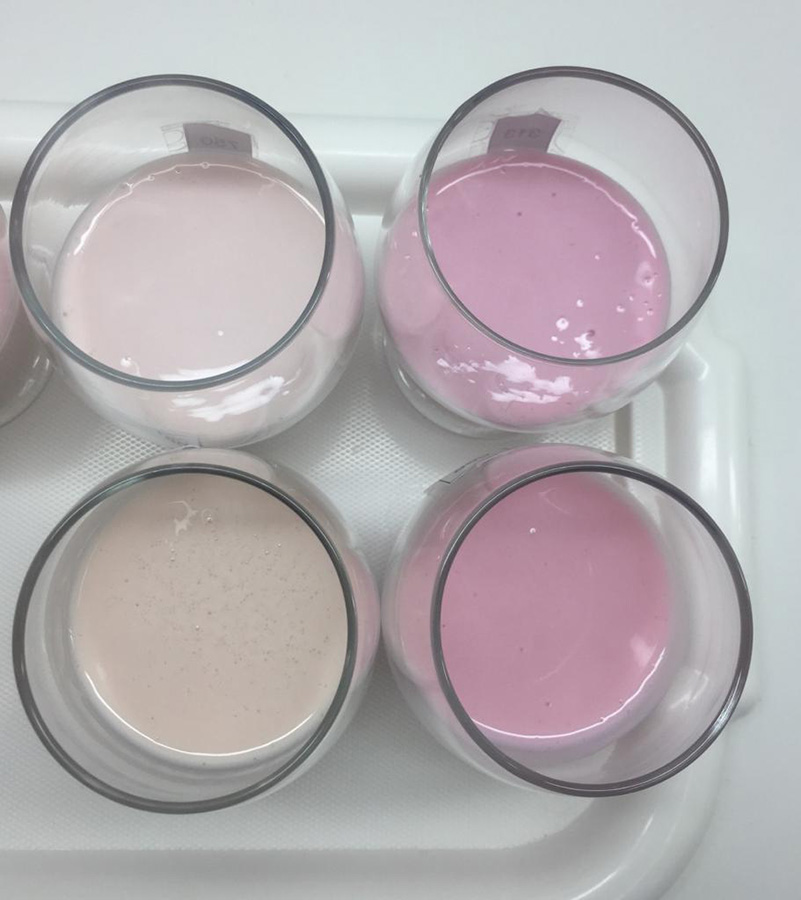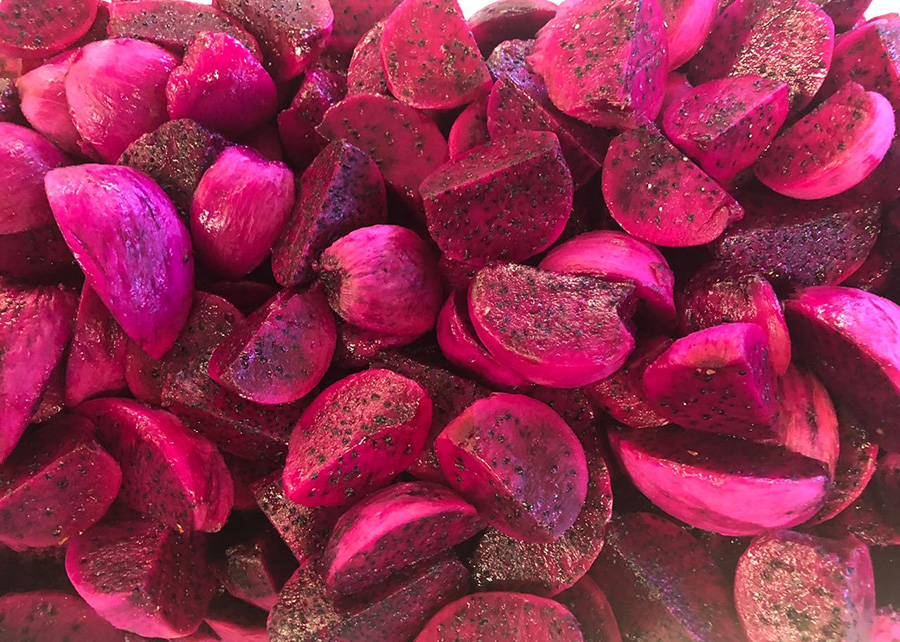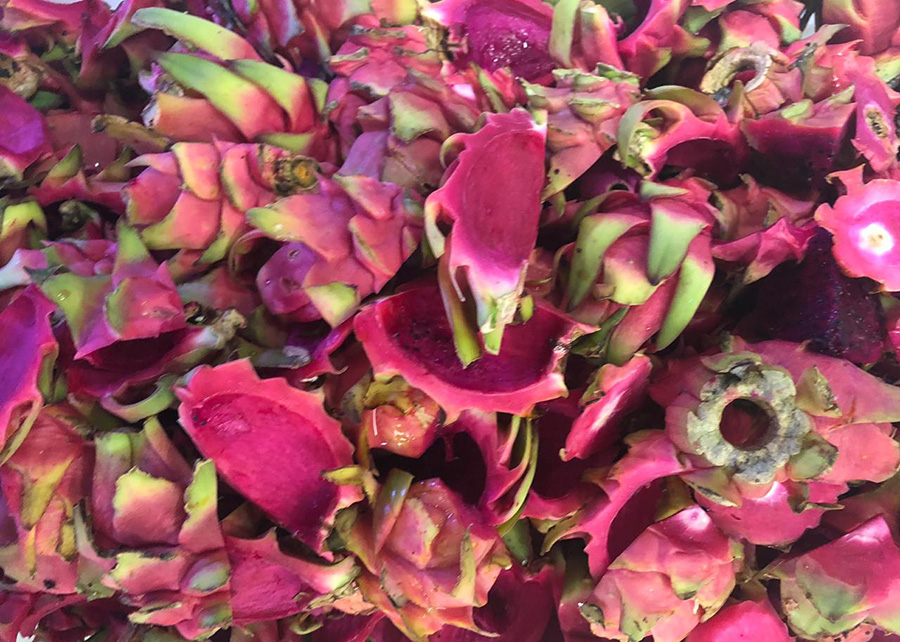The rich color of the new colorant allows different shades of red, violet and pink, which interest the food and cosmetics industries. It is an alternative to cochineal, the natural red colorant that industries use the most, and to beetroot-based products. It substitutes imported natural colorants with similar characteristics. The product is based on the principles of Green Chemistry and the bioeconomy, and adds value and income for farmers and industry. Easy cultivation and industrial use, on top of the colorant serving an expanding vegan market, contribute to structuring the dragon fruit production chain. The colorant is ready to be made on an industrial scale, and Embrapa, the product developer, is open to partnerships with interested companies. A natural, deep violet-red colorant, obtained with clean technology and good for health. Developed from dragon fruit (a variety of Hylocereus polyrhizus with red skin and pulp) in the laboratories of Embrapa Tropical Agroindustry, the product is ready to be upscaled by companies interested in producing it as an alternative for the billion-dollar colorant market. Out of all the advantages listed by the inventors of the technology, the most impressive undoubtedly is the color of the product, which, depending on the concentration, can make out different shades of red, violet and rose. "It is an input with very interesting characteristics for the food and cosmetics markets,” says one of the creators of the novelty, the researcher and project coordinator Guilherme Julião Zocolo. He explains that in recent years, companies have migrated from the use of artificial colorants to natural ones, despite the fact the former have lower production costs and desirable technological characteristics. Consumers have rejected artificial colorants due to their association to diseases and environmental impacts. The new product is a promising alternative to replace cochineal carmine, the natural red colorant that is most used by industries but that does not suit the plant-based market as it is made from insects. Another factor against cochineal is the possibility of allergies. In the American and European markets, the food industry is required to include the presence of cochineal in ingredient labels to avoid allergic reactions. The dragon fruit colorant is also an advantageous option against beetroot, the only large-scale alternative for red pigmentation besides cochineal. Unlike the one made from beets, the coloring made from dragon fruit does not present an aroma or flavor that requires additional neutralization processes. Beetroot has geosmins and pyrazines, molecules that give it an earthy flavor, and the various industrial processes required to bypass this effect are dominated by very few large companies. Advantages for the industry The food engineer from Embrapa Tropical Agroindustry Fernando Abreu explains that dragon fruit has a high industrial pulp yield: higher than 65%. According to him, another advantage is that its industrial processing only requires resizing equipment already used by the fruit pulp industries. “The pulp is easy to extract with cutter technologies and depulping by crushing, a type of extraction that has been tried and tested for melons”, he says. He underscores that the dragon fruit colorang offers an attractive color that resembles strawberry when used in dairy products. The industrial process of producting the colorant developed by Embrapa uses the technology of microfiltration by membranes. It is a much more complex process and even though it costs more, it offers the advantage of providing higher concentrations. “The more concentrated, the lower the transportation cost and better operational easiness”, he states. Green chemistry, bioeconomy and sustainability According to the researcher Ana Paula Dionísio, from Embrapa Tropical Agroindustry, the process to obtain the colorant, which is already on a pilot scale, follows the principles of Green Chemistry and meets a market trend set by consumers who are eager for clean-label processes. This concept has been gaining momentum and is associated both with easy-to-understand labels and with the idea of “more natural” products, that is, products that are free from food additives and preservatives. The use of a fruit that has adapted to the most different climates as an industrial ingredient can be classified as a major innovation asset. This technology paves the way for the creation of a market niche anchored on the concepts of the bioeconomy, researcher Guilherme Julião Zocolo observes. He believes that the development of the new product from a biodiversity asset creates great opportunities to add value and income for farmers and industries. "The development of the colorant is based on bioeconomy, in which natural resources and high technology are combined to create more sustainable products and services,” Zocolo says. For the researcher, a great advantage of the production process is that it can use dragon fruits that are not suited for the table fruit market, with the full use of their peels. Another important point is the replacement of imported natural colorants with these same characteristics. "This technology opens a window of opportunity to structure the chain.” The use of production systems that meet the demands of the industry should have a positive impact on small, medium, and large farms in the Brazilian semi-arid region,” Ana Dionísio adds. As she explains, the dragon fruit colorant may become a new source of jobs, income, and development in the Brazilian Northeastern regions that are heavily hit by periods of drought. The researcher recalls that dragon fruit can be cultivated nine months a year and it is a cactus that is easy to cultivate. Nutritional and functional value of the fruit Dragon fruit offered good results, in laboratory tests, in controlling cholesterol, glycemia, and anxiety. Other studies with dragon fruit previously conducted by scientists at Embrapa Tropical Agroindustry, Ceará State University (Uece) and the Federal University of Ceará (UFC) revealed that the fruit can be considered a functional food. The fruit was efficient in reducing cholesterol, LDL and triglycerols, and in elevating HDL. In diabetic animals, the dosages of 200 mg/kg and 400 mg/Kg showed promising pharmacological activities, significantly reducing glycemia in the treated group. The tests demonstrated anxiolytic effect and absence of toxicity in the concentrations assessed. Besides the tests to determine the fruit's functional action, the researchers observed the effect of processing on the metabolic, chemical, physical-chemical, enzymatic and volatile composition of the fruit pulp. “Dragon fruit has proved promising for the food industries, an even for pharmaceuticals, as a functional food and source of compounds of interest, that can be either be concentrated or isolated to broaden their effect”, says Guilherme Julião Zocolo, who also coordinated these studies. Photo: Ana Paula Dionísio
Photo: Ana Paula Dionísio
![Ana Paula Dionísio - Dragon fruit is an advantageous alternative to other raw materials used by the natural colorant industry Ana Paula Dionísio - Dragon fruit is an advantageous alternative to other raw materials used by the natural colorant industry]()
Dragon fruit is an advantageous alternative to other raw materials used by the natural colorant industry
-
The rich color of the new colorant allows different shades of red, violet and pink, which interest the food and cosmetics industries. -
It is an alternative to cochineal, the natural red colorant that industries use the most, and to beetroot-based products. -
It substitutes imported natural colorants with similar characteristics. -
The product is based on the principles of Green Chemistry and the bioeconomy, and adds value and income for farmers and industry. -
Easy cultivation and industrial use, on top of the colorant serving an expanding vegan market, contribute to structuring the dragon fruit production chain. -
The colorant is ready to be made on an industrial scale, and Embrapa, the product developer, is open to partnerships with interested companies. |
A natural, deep violet-red colorant, obtained with clean technology and good for health. Developed from dragon fruit (a variety of Hylocereus polyrhizus with red skin and pulp) in the laboratories of Embrapa Tropical Agroindustry, the product is ready to be upscaled by companies interested in producing it as an alternative for the billion-dollar colorant market.
Out of all the advantages listed by the inventors of the technology, the most impressive undoubtedly is the color of the product, which, depending on the concentration, can make out different shades of red, violet and rose. "It is an input with very interesting characteristics for the food and cosmetics markets,” says one of the creators of the novelty, the researcher and project coordinator Guilherme Julião Zocolo.
He explains that in recent years, companies have migrated from the use of artificial colorants to natural ones, despite the fact the former have lower production costs and desirable technological characteristics. Consumers have rejected artificial colorants due to their association to diseases and environmental impacts.
The new product is a promising alternative to replace cochineal carmine, the natural red colorant that is most used by industries but that does not suit the plant-based market as it is made from insects. Another factor against cochineal is the possibility of allergies. In the American and European markets, the food industry is required to include the presence of cochineal in ingredient labels to avoid allergic reactions.
The dragon fruit colorant is also an advantageous option against beetroot, the only large-scale alternative for red pigmentation besides cochineal. Unlike the one made from beets, the coloring made from dragon fruit does not present an aroma or flavor that requires additional neutralization processes. Beetroot has geosmins and pyrazines, molecules that give it an earthy flavor, and the various industrial processes required to bypass this effect are dominated by very few large companies.
 Advantages for the industry
Advantages for the industry
The food engineer from Embrapa Tropical Agroindustry Fernando Abreu explains that dragon fruit has a high industrial pulp yield: higher than 65%. According to him, another advantage is that its industrial processing only requires resizing equipment already used by the fruit pulp industries. “The pulp is easy to extract with cutter technologies and depulping by crushing, a type of extraction that has been tried and tested for melons”, he says.
He underscores that the dragon fruit colorang offers an attractive color that resembles strawberry when used in dairy products. The industrial process of producting the colorant developed by Embrapa uses the technology of microfiltration by membranes. It is a much more complex process and even though it costs more, it offers the advantage of providing higher concentrations. “The more concentrated, the lower the transportation cost and better operational easiness”, he states.
Green chemistry, bioeconomy and sustainability
According to the researcher Ana Paula Dionísio, from Embrapa Tropical Agroindustry, the process to obtain the colorant, which is already on a pilot scale, follows the principles of Green Chemistry and meets a market trend set by consumers who are eager for clean-label processes. This concept has been gaining momentum and is associated both with easy-to-understand labels and with the idea of “more natural” products, that is, products that are free from food additives and preservatives.
The use of a fruit that has adapted to the most different climates as an industrial ingredient can be classified as a major innovation asset. This technology paves the way for the creation of a market niche anchored on the concepts of the bioeconomy, researcher Guilherme Julião Zocolo observes. He believes that the development of the new product from a biodiversity asset creates great opportunities to add value and income for farmers and industries.
"The development of the colorant is based on bioeconomy, in which natural resources and high technology are combined to create more sustainable products and services,” Zocolo says. For the researcher, a great advantage of the production process is that it can use dragon fruits that are not suited for the table fruit market, with the full use of their peels. Another important point is the replacement of imported natural colorants with these same characteristics. "This technology opens a window of opportunity to structure the chain.”
The use of production systems that meet the demands of the industry should have a positive impact on small, medium, and large farms in the Brazilian semi-arid region,” Ana Dionísio adds. As she explains, the dragon fruit colorant may become a new source of jobs, income, and development in the Brazilian Northeastern regions that are heavily hit by periods of drought. The researcher recalls that dragon fruit can be cultivated nine months a year and it is a cactus that is easy to cultivate.
 Nutritional and functional value of the fruit Nutritional and functional value of the fruit
Dragon fruit offered good results, in laboratory tests, in controlling cholesterol, glycemia, and anxiety. Other studies with dragon fruit previously conducted by scientists at Embrapa Tropical Agroindustry, Ceará State University (Uece) and the Federal University of Ceará (UFC) revealed that the fruit can be considered a functional food. The fruit was efficient in reducing cholesterol, LDL and triglycerols, and in elevating HDL. In diabetic animals, the dosages of 200 mg/kg and 400 mg/Kg showed promising pharmacological activities, significantly reducing glycemia in the treated group. The tests demonstrated anxiolytic effect and absence of toxicity in the concentrations assessed. Besides the tests to determine the fruit's functional action, the researchers observed the effect of processing on the metabolic, chemical, physical-chemical, enzymatic and volatile composition of the fruit pulp. “Dragon fruit has proved promising for the food industries, an even for pharmaceuticals, as a functional food and source of compounds of interest, that can be either be concentrated or isolated to broaden their effect”, says Guilherme Julião Zocolo, who also coordinated these studies. Photo: Ana Paula Dionísio |
Verônica Freire (MTb 01125/CE)
Embrapa Tropical Agroindustry
Press inquiries
agroindustria-tropical.imprensa@embrapa.br
Translation: Mariana Medeiros (13044/DF)
General Secretariat
Further information on the topic
Citizen Attention Service (SAC)
www.embrapa.br/contact-us/sac/

 Advantages for the industry
Advantages for the industry 